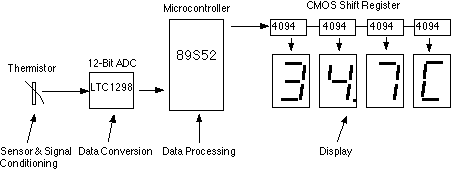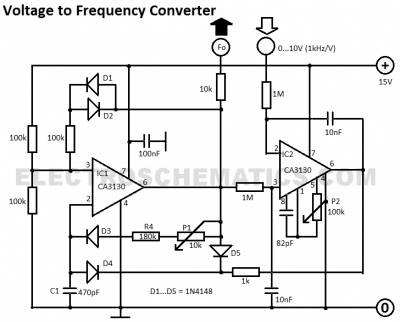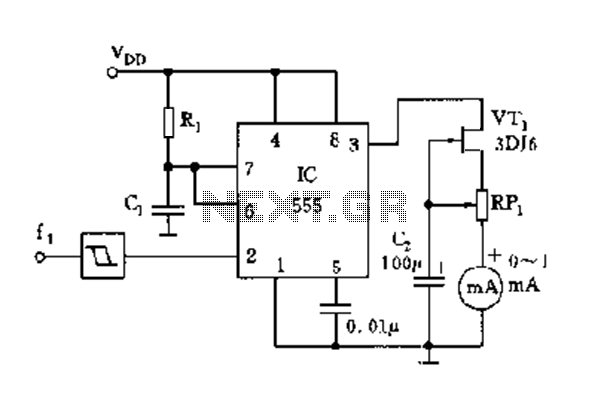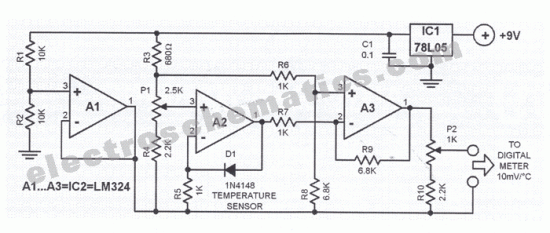
Voltage output humidity sensor meter circuit HM1500 / 1520 with microprocessor PIC16F874
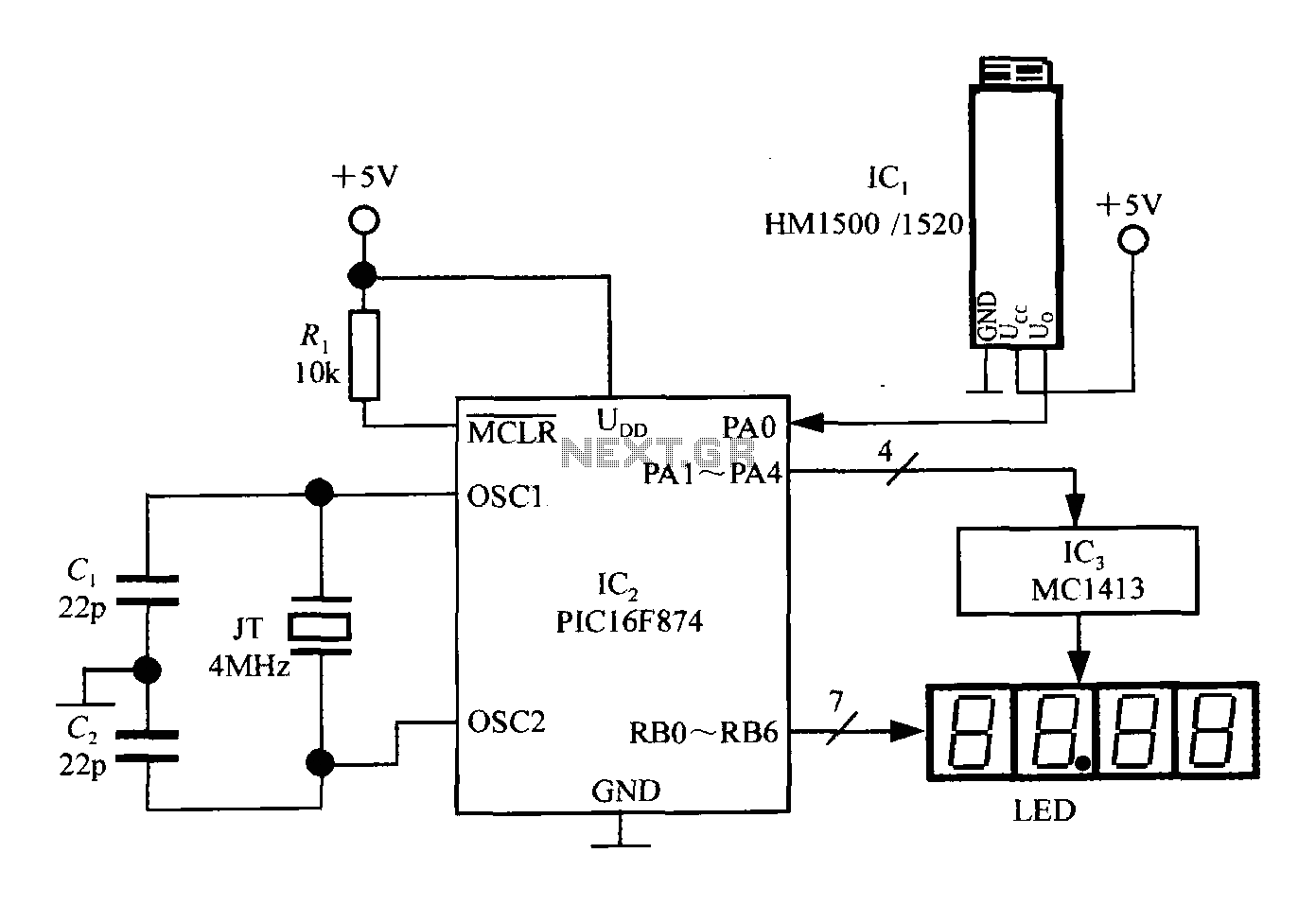
An intelligent humidity meter circuit utilizing the HM1500/1520 humidity sensor and a microcontroller configuration. The circuit operates on a +5V power supply and incorporates four common cathode LED digital displays. It employs three integrated circuits: IC1 is the HM1500/1520 humidity sensor, IC2 is a 10-bit ADC microcontroller from Microchip, specifically the PIC16F874, and IC3 is a Darlington inverter drive array (MC1413). The PIC16F874 is an economical 8-bit microcontroller featuring an 8-channel successive approximation A/D converter, allowing for the conversion of up to 8 humidity signal analog inputs to digital format. The circuit utilizes a 4MHz quartz crystal oscillator (JT) with coupled capacitors (C1, C2) to provide the necessary clock frequency for the microcontroller. The PIC16F874 operates within a wide voltage range (+2.5V to +5V), making it suitable for low-voltage applications, with a quiescent current of less than 2mA. The RA port (RA0 to RA7) serves as the I/O interface, with PA0 (also known as AIN0) receiving the voltage signal from the humidity sensor. The PA1 to PA4 outputs generate scanning signals for the MC1413 inverter drive. The RB0 to RB6 outputs provide the 7-segment code signals for the LED display segments a to g. Additionally, the PIC16F874 features power-down protection, with the MCLR pin facilitating a brownout reset. When the supply voltage drops from +5V to +4V, the chip enters a reset state. After the voltage returns to normal, a 72ms delay is required before the chip resumes normal operation. Data stored in RAM during a power failure remains intact and is not lost.
The intelligent humidity meter circuit is designed to measure and display relative humidity levels accurately. The HM1500/1520 humidity sensor (IC1) detects humidity in the environment and outputs an analog voltage proportional to the humidity level. This analog signal is fed into the PIC16F874 microcontroller (IC2), which contains an integrated 10-bit successive approximation ADC that converts the analog signal into a digital format for processing.
The microcontroller is clocked by a 4MHz oscillator, ensuring efficient operation and timely processing of the input signals. The use of capacitors (C1 and C2) stabilizes the oscillator circuit, providing a reliable clock signal for the microcontroller.
The microcontroller’s I/O ports are configured to facilitate interaction with the humidity sensor and the LED display. The PA0 pin is dedicated to reading the analog voltage from the humidity sensor, while the PA1 to PA4 pins are used to generate scanning signals that control the MC1413 inverter, which drives the common cathode LED displays. The RB0 to RB6 pins output the necessary signals to light up the corresponding segments of the 7-segment displays, allowing for clear visual representation of the humidity readings.
The PIC16F874's power management features ensure that the device remains operational within a specified voltage range. The brownout reset feature protects the microcontroller from erratic behavior during voltage drops, and the retention of RAM data during power loss enhances reliability in applications where power stability may be a concern.
Overall, this intelligent humidity meter circuit is a robust solution for monitoring humidity levels, making it suitable for various applications in environmental control, HVAC systems, and other areas where humidity measurement is critical.Intelligent humidity meter circuit by the HM1500 / 1520 humidity sensor and MCU configuration shown in Fig. The meter + 5V power supply, with four common cathode LED digital tube. CCP uses three circuit IC: IC1 to HM1500 / 1520 humidity sensor, IC2 is produced by the US microchip band (Microchip) Company 10-bit ADC of microcontroller PIC16F874, IC3 7 Darlington inverter drive array MC1413. PIC16F874 is a cost-effective 8-bit microcontrollers, containing 8 10 successive approximation A / D converter, up to 8 humidity signal analog to digital conversion, is only the way in which.
JT is 4MHz quartz crystal oscillators coupled capacitors C1, C2 can be provided after 4MHz clock frequency of the microcontroller. PIC16F874 wide supply voltage range (+ 2.5 ~ + 5V), suitable for low voltage power supply, quiescent current is less than 2mA.
RA port (RA0 ~ RA7) for the I / O interface, now use PA0 (also known AIN0) opening line to receive the voltage signal generated by the humidity sensor. PA1 ~ PA4 output bit scanning signal, bit-MC1413 obtained by inverting the drive signal. RB0 ~ RB6 output RB mouth 7-segment code signal, then the corresponding electrode segment LED display pen a ~ g.
PIC16F874 also has a power-down protection, MCLR to brownout reset latch side. When UDD from + 5V down to + 4V, the chip enters the reset state. When the power supply has returned to normal, must 72ms delay before the detachment state into normal state. Data during power failure RAM remain unchanged, will not be lost.
The intelligent humidity meter circuit is designed to measure and display relative humidity levels accurately. The HM1500/1520 humidity sensor (IC1) detects humidity in the environment and outputs an analog voltage proportional to the humidity level. This analog signal is fed into the PIC16F874 microcontroller (IC2), which contains an integrated 10-bit successive approximation ADC that converts the analog signal into a digital format for processing.
The microcontroller is clocked by a 4MHz oscillator, ensuring efficient operation and timely processing of the input signals. The use of capacitors (C1 and C2) stabilizes the oscillator circuit, providing a reliable clock signal for the microcontroller.
The microcontroller’s I/O ports are configured to facilitate interaction with the humidity sensor and the LED display. The PA0 pin is dedicated to reading the analog voltage from the humidity sensor, while the PA1 to PA4 pins are used to generate scanning signals that control the MC1413 inverter, which drives the common cathode LED displays. The RB0 to RB6 pins output the necessary signals to light up the corresponding segments of the 7-segment displays, allowing for clear visual representation of the humidity readings.
The PIC16F874's power management features ensure that the device remains operational within a specified voltage range. The brownout reset feature protects the microcontroller from erratic behavior during voltage drops, and the retention of RAM data during power loss enhances reliability in applications where power stability may be a concern.
Overall, this intelligent humidity meter circuit is a robust solution for monitoring humidity levels, making it suitable for various applications in environmental control, HVAC systems, and other areas where humidity measurement is critical.Intelligent humidity meter circuit by the HM1500 / 1520 humidity sensor and MCU configuration shown in Fig. The meter + 5V power supply, with four common cathode LED digital tube. CCP uses three circuit IC: IC1 to HM1500 / 1520 humidity sensor, IC2 is produced by the US microchip band (Microchip) Company 10-bit ADC of microcontroller PIC16F874, IC3 7 Darlington inverter drive array MC1413. PIC16F874 is a cost-effective 8-bit microcontrollers, containing 8 10 successive approximation A / D converter, up to 8 humidity signal analog to digital conversion, is only the way in which.
JT is 4MHz quartz crystal oscillators coupled capacitors C1, C2 can be provided after 4MHz clock frequency of the microcontroller. PIC16F874 wide supply voltage range (+ 2.5 ~ + 5V), suitable for low voltage power supply, quiescent current is less than 2mA.
RA port (RA0 ~ RA7) for the I / O interface, now use PA0 (also known AIN0) opening line to receive the voltage signal generated by the humidity sensor. PA1 ~ PA4 output bit scanning signal, bit-MC1413 obtained by inverting the drive signal. RB0 ~ RB6 output RB mouth 7-segment code signal, then the corresponding electrode segment LED display pen a ~ g.
PIC16F874 also has a power-down protection, MCLR to brownout reset latch side. When UDD from + 5V down to + 4V, the chip enters the reset state. When the power supply has returned to normal, must 72ms delay before the detachment state into normal state. Data during power failure RAM remain unchanged, will not be lost.
Warning: include(partials/cookie-banner.php): Failed to open stream: Permission denied in /var/www/html/nextgr/view-circuit.php on line 713
Warning: include(): Failed opening 'partials/cookie-banner.php' for inclusion (include_path='.:/usr/share/php') in /var/www/html/nextgr/view-circuit.php on line 713

